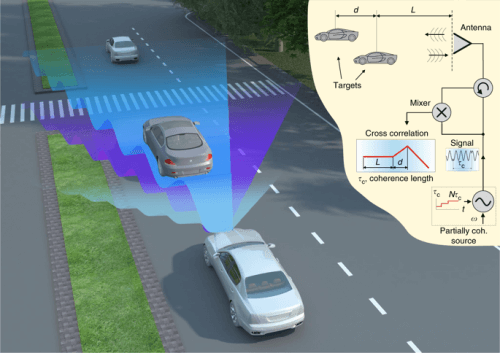The system is able to operate efficiently and accurately even with a bandwidth 100 times lower than what is required today, and can distinguish hidden objects, such as a child bursting onto the road behind a parked car or a vehicle emerging quickly around a corner. The study was published this weekend in the journal Nature Communications

Researchers at Tel Aviv University, led by Prof. Pavel Ginzburg from the School of Electrical Engineering in the Faculty of Engineering, have developed a new type of radar that is capable of distinguishing between objects with extremely high resolution even when operating at a bandwidth 100 times smaller than that required by existing technologies. Such a radar that will be integrated into a smart or autonomous vehicle has several important advantages: thanks to the high resolution, it is able to warn of objects hidden from view - such as, for example, a child who bursts into the road behind a car; And thanks to the low bandwidth, it is relatively cheap to operate, and does not interfere with the operation of other devices in the environment - such as similar radars installed in other cars.
Doctoral student Vitaly Kozlov from Prof. Ginzburg's laboratory participated in the study. The article was published late last week in the journal Nature Communications.
"Smart and/or autonomous cars, of the present and the future, contain a large number of different types of sensing means, which replace the human driver's senses (and sometimes even surpass them), and allow the vehicle to orient itself in space," explains Prof. Ginzburg. "Among other things, the smart car is integrated with radars that detect objects that are in front of the vehicle even in conditions of fog, rain, darkness or blinding sun, measure the distance to the object (person, car, tree...), and even send an alert to the brakes if necessary. The radar's ability to distinguish between different objects that are close to each other is called resolution, and a high-resolution radar can also distinguish objects apparently hidden by other objects. Such a radar is capable, for example, of spotting a child who is about to burst onto the road behind a parked car, and send an order for immediate braking."
Vitaly Kozlov adds: "Although there are radar technologies with high resolutions today, they all rely on high bandwidth - that is, the radar must transmit and receive signals in a large frequency range. This fact poses difficulties for the autonomous vehicle: already today there is a density of transmission frequencies in the air, therefore the use of high bandwidth is expensive, and may also interfere with the activity of other devices in the environment - especially radars installed in other autonomous cars. In fact, without a solution to the problem, many autonomous vehicles will have difficulty moving side by side on the roads. We approached the subject from a completely new direction, which has not been attempted until now: the application of principles from the field of optics to radars. This is based on the understanding that both the light that the optics deals with and the radar signals are electromagnetic waves, which differ from each other mainly in the wavelength: in optics, we are dealing with nanometer wavelengths, while radars use giga-keratz frequencies - wavelengths measured in millimeters or centimeters."
Specifically, the researchers relied on the principle of coherence borrowed from optics, and used, among other things, in OCT (Optical Coherent Tomography) imaging devices, which enable high-resolution three-dimensional imaging of dynamic biological tissues. "We realized that there is a similarity in complexity and dynamism between biological tissues and the movement of vehicles on the road, so the solution for creating a high-quality image may also be similar," says Prof. Ginzburg. Therefore, inspired by the OCT device, the new radar relies on the partial coherence property of the electromagnetic radiation.
Based on the groundbreaking concept, the researchers built a radar device, developed a theoretical model for it, and tested in the laboratory the compatibility between the hardware and the theory. For the purpose of the experiment, they placed two metal plates (targets) at a distance of about 32 cm from each other, and even one behind the other, and checked what was required for the radar to distinguish between them. "A normal radar needs a bandwidth of about 500 MHz to distinguish between two such targets," says Vitaly Kozlov. "Our radar 'settled' for this with a bandwidth smaller than 30 MHz. More than that: according to the theory we developed, which was proven to be compatible with the experiment, the bandwidth can be as small as we want, and the resolution will remain high. This is because the separation capacity (resolution) in our radar is not related to the bandwidth at all, but relies on a completely different physical principle."
"Unlike all existing radar technologies, our method allows the radar to distinguish between objects with high resolution, without needing a high and expensive bandwidth," Prof. Ginzburg concludes. "This is a groundbreaking solution to a fundamental problem in the future technology of autonomous vehicles. A radar that will be developed based on our method will be convenient and relatively cheap to operate, and will allow many autonomous vehicles to move side by side safely, and without interfering with other radars operating in the vicinity."
for the scientific article

2 תגובות
the link is not working
Even after narrowing the required bandwidth, there is still the problem of interference from similar radars in the surrounding vehicles.
But now it will be easier to overcome this with the help of rapid random changes in frequencies so that each vehicle will recognize its own random changes and be able to locate the echoes of its signal among all the others.